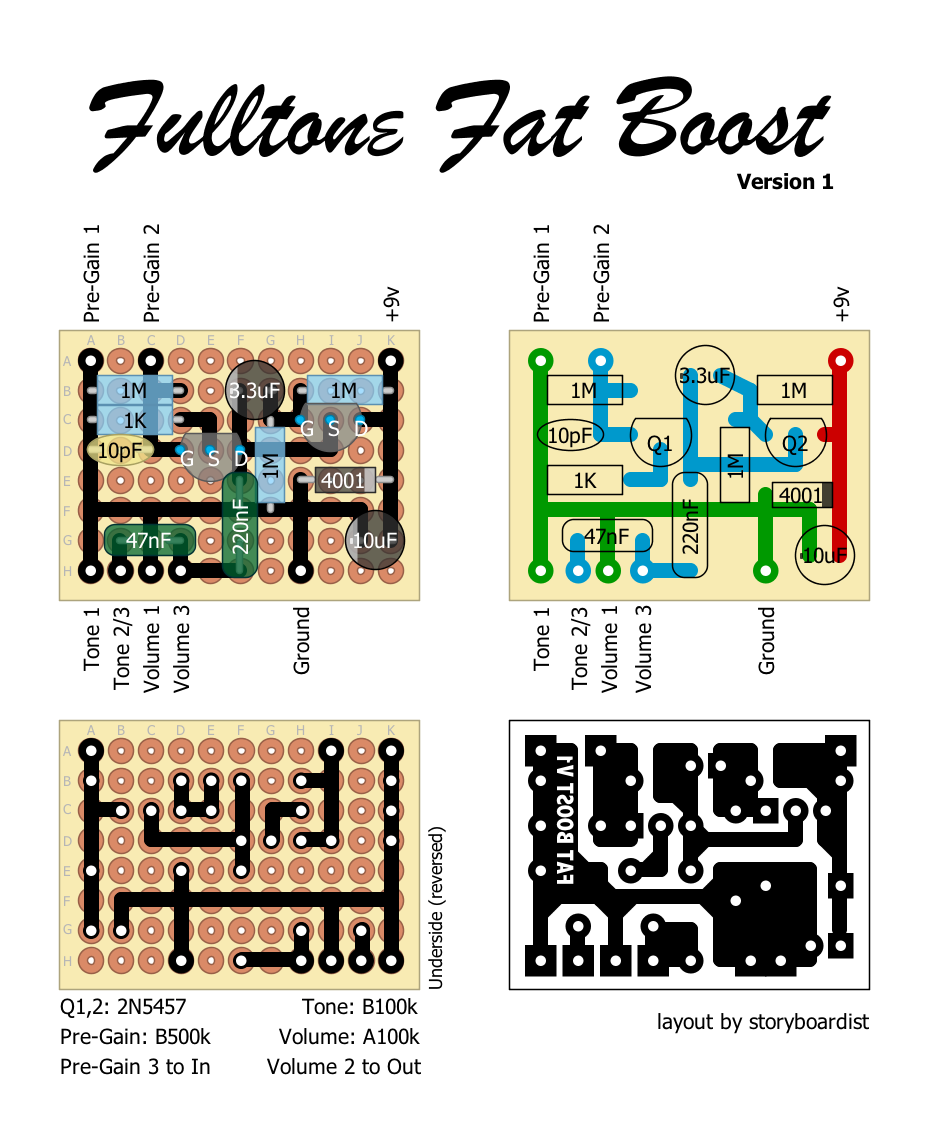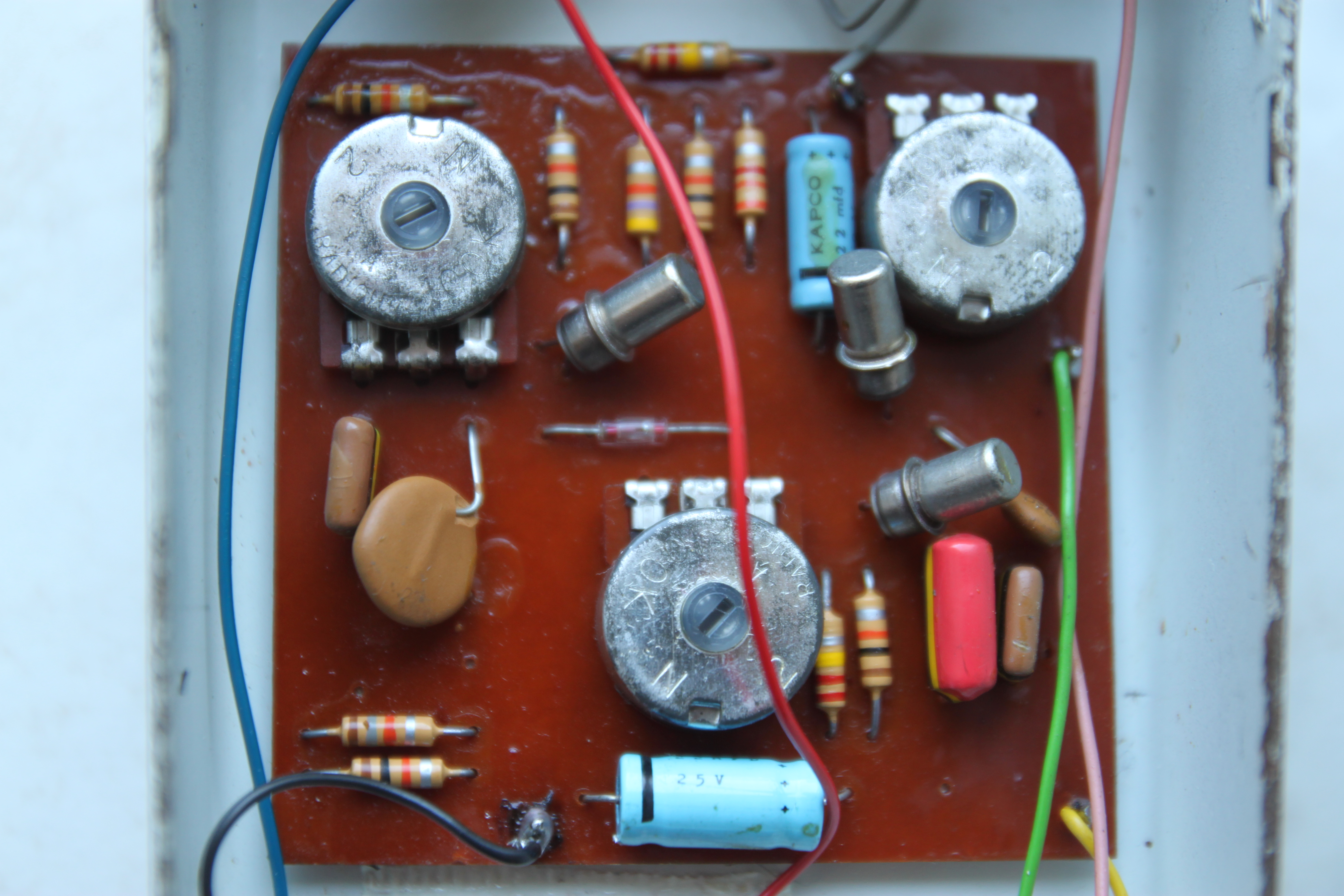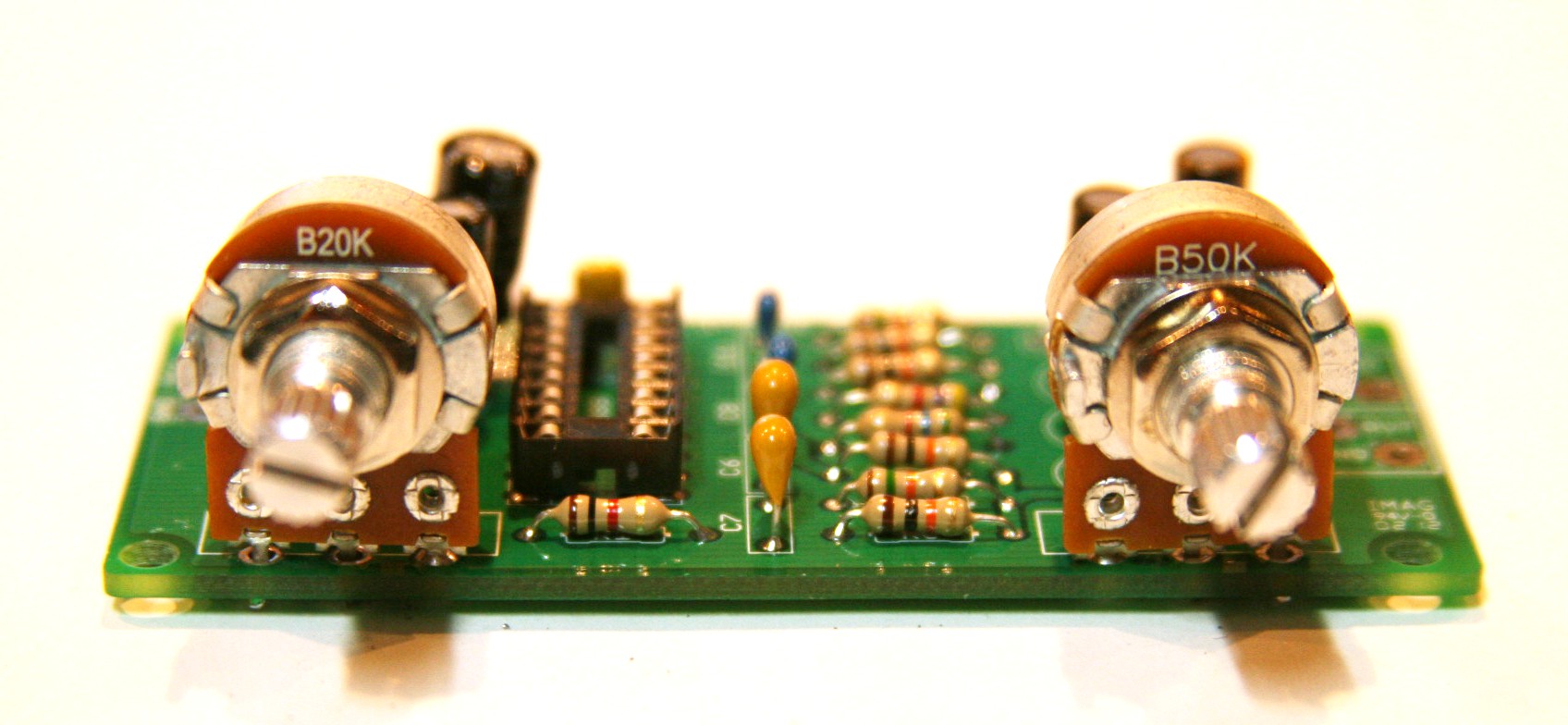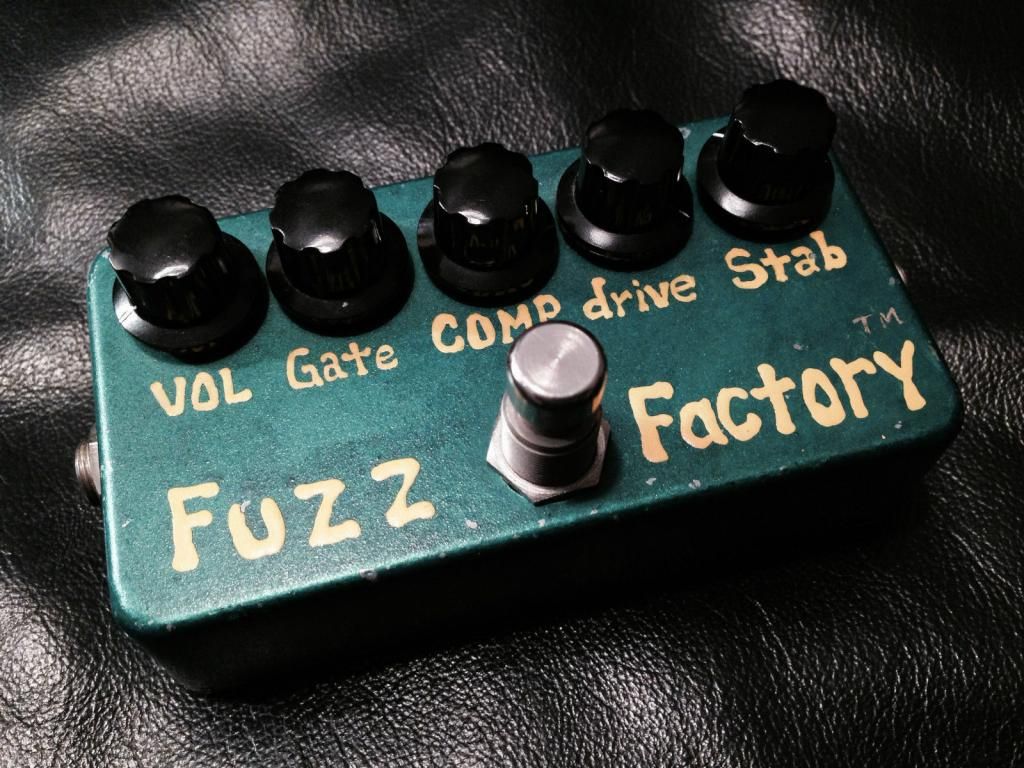Last post of 2014. Happy New Year, everybody!
Here's the early 80s DOD FX55 Distortion, without the original switching circuit so you can wire it for true bypass. The original used a TL062 dual op-amp, but the 2nd half of it wasn't in the signal path all, so I went with the single TL061. The off-board wiring pads aren't as neat as I'd like, but I wanted it to fit in a 1590a.
You could fairly easily use this same layout to make the DOD FX50 overdrive with the following mods:
• Change the 1k resistor to 4.7k
• Change the 3.9M resistor to 1M
• Place a 1n capacitor between lugs 1 and 3 on the Level pot
This is a library of perfboard and single-sided PCB effect layouts for guitar and bass. I'm not an electrical engineer by any stretch of the imagination, just a DIY'er who likes drawing layouts. It is meant for the hobbyist (so commercial use of any of these layout is not allowed without permission) and as a way to give back to the online DIY community.
Wednesday, December 31, 2014
Tuesday, December 30, 2014
Lovepedal Black Magic
Haven't done a layout with board mounted pots in a while, so here's the Lovepedal Black Magic. It's a LM386 based distortion that tries to get achieve the "Brown Sound." I added polarity protection and put the LED resistor on the board as well.
Friday, December 19, 2014
Run Off Groove Modified EA Tremolo
Here's Run of Groove's take on the DIY classic EA Tremolo. I've laid it out so that the rate indicator LED can also be used as the on/off indicator.
Here's how you'd wire the LED to a 3PDT switch as the on/off indicator.
Thursday, December 18, 2014
MXR Phase 45
I've seen a lot of different PCB layouts online for this effect, but all of them had at least one jumper on the board. Jumpers aren't the end of the world, but I know for me, if I'm going to go to all the trouble of etching a PCB, I don't want to mess with jumpers. This layout is jumper-free and will still fit in a 1590B type enclosure.
MXR released the Phase 45 along side the more famous Phase 90 in 1975. The name comes from the number of degrees of the phase shift it's capable of. Some say it's similar in sound to a UniVibe and can be modded into being more of a vibe pedal.
The original units used 2N5952 for the FETs (make sure you match them by the way), but others can be used. I listed 2N5457 in the layout because they're what I have on hand. MPF102, J201, or 2N5458s could also be used. Really, any FET with the DSG pinout.
If you want, you can hardwire the C500k pot to the top of the board, though I would suggest using a long leg PCB mount pot (like these) and mounting it above the component side of the board (like this).
MXR released the Phase 45 along side the more famous Phase 90 in 1975. The name comes from the number of degrees of the phase shift it's capable of. Some say it's similar in sound to a UniVibe and can be modded into being more of a vibe pedal.
The original units used 2N5952 for the FETs (make sure you match them by the way), but others can be used. I listed 2N5457 in the layout because they're what I have on hand. MPF102, J201, or 2N5458s could also be used. Really, any FET with the DSG pinout.
If you want, you can hardwire the C500k pot to the top of the board, though I would suggest using a long leg PCB mount pot (like these) and mounting it above the component side of the board (like this).
Tuesday, December 16, 2014
Dan Armstrong Orange Squeezer
The Dan Armstrong Orange Squeezer compressor has become a staple among the DIY community. Original units plugged straight into the guitar, with no external controls except for an on/off switch. This layout has the level control offboard, but the bias is a 10k trimpot, but could easily be wired offboard as well. And you should be able to squeeze it into a 1590A. (See what I did there? :D)
Edit:
Here are a few mods if you want to use it on bass. Some say stock is best, others say to uses these substitutions. As always, YMMV.
• Swap the output cap from 4.7µ to 1µ (between the 390k and 1.5k resistors, below the IC)
• Swap bleeder cap from 4.7µ to 10µ (cap connected to the 1N34 diode)
• Reduce the feedback resistor from 220k to 200k (between Q2 and the IC)
Here are a few mods if you want to use it on bass. Some say stock is best, others say to uses these substitutions. As always, YMMV.
• Swap the output cap from 4.7µ to 1µ (between the 390k and 1.5k resistors, below the IC)
• Swap bleeder cap from 4.7µ to 10µ (cap connected to the 1N34 diode)
• Reduce the feedback resistor from 220k to 200k (between Q2 and the IC)
Wampler Plexi-Drive
Here's Wampler's Plexi-Drive, another Marshall-in-a-box pedal. The original unit uses a 470µ capacitor for power filtering, which seems like overkill to me. I've replaced that with a 100µ cap that should do the job just fine.
Some build reports on FSB say that the 15k resistors from 9V to the drains of the J201s might need to be tweaked to bias the JFETs correctly (4.5v), so either socket those positions or use trimpots. Also, if the tone control is too dark sounding for your taste, replace that A25k pot with an A500k to brighten things up.
Some build reports on FSB say that the 15k resistors from 9V to the drains of the J201s might need to be tweaked to bias the JFETs correctly (4.5v), so either socket those positions or use trimpots. Also, if the tone control is too dark sounding for your taste, replace that A25k pot with an A500k to brighten things up.
Monday, December 15, 2014
Ramble FX Marvel Drive (version 1)
One of the many Plexi-in-a-pedal options out there, the Marvel Drive has parallel input stages allowing you to create your own blend between the normal "channel" and the treble "channel." Gearmandude can show you better than I can try to explain it:
Friday, December 12, 2014
Basic Audio Scarab Deluxe
This is a variation of the Mictester Silicon Tonebender, which is based of the Tone Bender Mk II Professional circuit. John Lyons was kind enough to shed some light on his version over at FSB.
Earthquaker Devices Crimson Drive (2-knob version)
Here's a good sounding overdrive from Earthquaker Devices. This is for the first incarnation of the Crimson Drive with just level and gain controls. Uses a J201 in a buffer stage and a PNP AC128 in the gain stage.
Dirk_Hendrik from FSB traced one and drew this schematic.
Dirk_Hendrik from FSB traced one and drew this schematic.
The power filter section makes me scratch my head a bit, as it uses 2, 100µ caps. To keep things a little simpler on the board I just put one 220µ cap, since the equivalent capacitance of two parallel capacitors is the sum of the individual capacitances.
Also note that the schematic calls for a low current LED, hence the 10k resistor from the power supply. Change that resistor to around 2.2k if you're using a more common LED.
Tuesday, December 9, 2014
Simple Transistor Compressor
FSB member Mictester came up with this design a couple years ago. Utilizes 4 transistors, 1 PNP and 3 NPN, though you could probably use an NPN in place of the PNP. Best to socket and try a few different transistors. The schematic says BC213L for Q1 and BC183L for Q2-4, but any medium gain transistors should work okay (2N2222, 2N2907, 2N3904, 2N3906). I added some of the mods suggested in the FSB thread for higher input impedance and noise reduction.
Rockett WTF
Mmolteratx traced this one over on FSB. Figured I'd put it up. Seems to be a BossTone derivative with some tweaks. Here's the original:
And since all the offboard wiring is making a few people say, "WTF," here's the rat's nest that is the offboard wiring for this effect. The "In" and "Out" wires go to the normal 3PDT switch you'd use for effect on/off.
Monday, December 8, 2014
Electro Harmonix Ram's Head Big Muff
There are a lot of versions and subversions of the Big Muff. Many consider the Violet Ram's Head to be the best, though many consider the Triangle, or IC, or Green Russian, etc. the best. YMMV
This one has the pots hard mounted to the board, though depending on the enclosure you use, it may be best to wire them off-board. This layout is heavily inspired by the original Ram's Head circuit board, just resized for more typical sized components. I've also added a polarity protection diode, power filtering cap, and an LED resistor.
This one has the pots hard mounted to the board, though depending on the enclosure you use, it may be best to wire them off-board. This layout is heavily inspired by the original Ram's Head circuit board, just resized for more typical sized components. I've also added a polarity protection diode, power filtering cap, and an LED resistor.
EHX also used this same circuit for the Guild Foxey Lady (3-knob) as well as several other OEM pedals EHX produced.
Friday, December 5, 2014
Zvex Wooly Mammoth
The Zvex Wooly Mammoth is a Fuzz Face derivative designed for bass, but sounds awesome on guitar as well. For this one I've laid it out for on board pots oriented like the originals. On the PCB I added an LED and LED resistor for on/off indication. As with my layout for the Fuzz Factory, this layout is designed for the pots to be mounted on the component side of the board.
Wednesday, December 3, 2014
ProCo RAT ('86 version)
Since I did the Blower Box yesterday, and it's essentially a RAT, I figured it wouldn't take too much effort to convert that layout to the original. So here's the original '86 RAT.
Tuesday, December 2, 2014
Idiot Box Effects Blower Box
Here's a pretty cool bass distortion based on the RAT. The normal filter section on a RAT is replaced with a passive baxandall network. It was traced by FSB member p.eat and the schematic I based this layout from was drawn by johnk.
Run Off Groove Odie
Here's the Odie from Run Off Groove. It's an alternative to the Tube Screamer using JFETs. Be sure to adjust the drain trimpots to 1/2 the supply voltage. Sound clips can be found here.
This one is verified (and sounds fantastic). Here's a few pics of my build.
Monday, December 1, 2014
Univox SuperFuzz (stock)
Here's a layout for the stock Univox SuperFuzz. I probably should have drawn this one first and then the modded one below, but it was actually easier to take the modded layout and reverse it back to stock.
Friday, November 28, 2014
Univox SuperFuzz (modded)
Here the Univox SuperFuzz with the mods done by FSB member derringer. It replaces the stock tone switch with a pot, as well as a few other useful mods. Socket the 2 ceramic caps going from the base to collector on Q1 and Q6 and try some different values (I'm guessing in the 100pf to 500pf range). This one's a little on the wide side, so you'd be hard pressed to fit it in a 1590B, but it should fit quite nicely in a 1590BB.
Wednesday, November 26, 2014
Mosrite Fuzzrite
Here another classic fuzz, the Mosrite Fuzzrite. This is the silicon version. The original transistors were marked "TZ82" so be sure to use sockets and try a few different ones out. The original pots were 350k and 33k, which are going to be difficult values to track down. You can either use 500k and 50k, or use 500k and 50k and add fixed resistors in parallel (between lugs 1 and 3) to try and recreate the original values.
Saturday, November 22, 2014
DOD Overdrive 250 Grey Spec
Here's the grey spec DOD Overdrive 250 that fits in a 1590a enclosure. You could also build a yellow spec 250 or the MXR Distortion + with this layout. Just compare the schematics and value swaps.
Friday, November 21, 2014
Crap-Fi Delay
Here's a fairly simple PT2399 delay from Allesz over on FSB. Here's what he had to say about it:
It is a simple circuit and it works good but: the mix and repeats pot are a little interactive in quite a strange way (anyway they work different from a standard echo: to turn off the delay you don'use the mix pot, but you turn to zero the feedback pot) and the on off is a little bit noisy (the clip is recorded at low volume and you will hear kids (always noisy) and clicks so, mostly, the clicks are from the mechanical sound of the switch, but a little noise makes it to the amp too) in order to minimize the clicks the input is grounded on bypass.
The major differences between my schem and the others pt2399 projects I know are that I didn't use the opamp between pins 14 and 13 and I didn't put a cap between pin 2 and three (repeats sounded cleaner to me this way).
I put a small switch to select between long and short delay; the long delays are quite dirty.
It is a simple circuit and it works good but: the mix and repeats pot are a little interactive in quite a strange way (anyway they work different from a standard echo: to turn off the delay you don'use the mix pot, but you turn to zero the feedback pot) and the on off is a little bit noisy (the clip is recorded at low volume and you will hear kids (always noisy) and clicks so, mostly, the clicks are from the mechanical sound of the switch, but a little noise makes it to the amp too) in order to minimize the clicks the input is grounded on bypass.
The major differences between my schem and the others pt2399 projects I know are that I didn't use the opamp between pins 14 and 13 and I didn't put a cap between pin 2 and three (repeats sounded cleaner to me this way).
I put a small switch to select between long and short delay; the long delays are quite dirty.
Thursday, November 20, 2014
Escobedo Octup!
Here's a clean octave up effect from Tim Escobedo. The Bias control offer subtle changes, which is why I have it as an external pot. He mentioned it might need a booster in front of it, just FYI.
Wednesday, November 19, 2014
Fulltone Fat Boost v1
There was some controversy over this pedal from Fulltone as the circuit is practically identical to the Jack Orman Mini-Booster. Fulltone no longer makes this version of the Fat Boost and now makes a 4-control version with an extra FET stage and more EQ controls. Regardless, it's a great pedal for beefing up your tone.
The perf and PCB layouts are slightly different. I was able to give the components more breathing room on the PCB that wouldn't be feasible on perf.
Tuesday, November 18, 2014
Run Off Groove Peppermill
Here's a nice transparent drive from Runoffgroove.com. Not a ton of headroom apparently, but has a nice bluesy tone. In the layout, Q1 is oriented for a 2N7000, so if you use a BS170 be sure to rotate it 180º.
Monday, November 17, 2014
Way Huge Red Llama
The Red Llama by Way Huge is a great tube-like overdrive with plenty of output. I've drawn 3 layouts–one for every typical Hammond box! The 1590A layout uses 9mm pots which you should be able to board-mount. The other 2 use typical 16mm pots. Make sure to use the unbuffered CD4049 or else the circuit won't work.
Saturday, November 15, 2014
SolaSound Tone Bender Mk. III
Smoother sounding than the Mk. II Professional, the Tone Bender Mk. III not only added a tone control, but the circuit was a deviation from earlier Tone Benders. Q1 and 2 create a Darlington pair that amplify the signal, while Q3 is what creates the fuzz. I've laid this out for negative ground operation, so make sure to use NPN transistors. Q1 and 2 can be low gain silicon if you don't want to use germaniums. Q3 could also be silicon, but a germanium is most likely going to sound best. You can also reduce the value of the 220k resistor (or just replace with a jumper) between Tone 2 and Volume 3 for more output.
Here's a compact layout:
Here's a compact layout:
The original TB3 had a cool way of mounting the pots to the circuit board (see pic below). This approach was later emulated by Ross with their Distortion, Compressor, and Phaser pedals, and ProCo with the RAT.
Since I'm a sucker for eliminated offboard wiring, I created another layout (PCB only, sorry) inspired by the original, but updated for more modern components (like radial electrolytic caps and 16mm pots) and to fit in a 1590B or 125B.
And a shot with the components not in "outline" mode.
This has an optional 1M resistor between the base and collector of Q3 if using silicon transistors.
This layout can also be used for the Vox ToneBender Mk. III and the 3-knob Park Fuzz. See Fuzz Central for component changes.
Friday, November 14, 2014
Klon Buffer
Who doesn't love a Klon, right? Here's the buffer stage of the Centaur. The original Klon uses one side of a TL072 for the buffer and the other for gain stage. If you're building the just the buffer, you can get away with a TL071. I've laid out a perf and PCB for each.
Jordan BossTone
Many associate this pedal with the fuzz tone for "Spirit in the Sky" by Prodigal Son, though I'm fairly sure that theory has been debunked. At any rate, it's a great sounding fuzz, and should be a fairly easy build.
Monolith Oracle Fuzz
This is a pretty cool fuzz box. It's a cross (sonically anyway) between an early Vox Tone Bender and a Big Muff. It uses PNP germanium transistors, but still uses a negative ground power supply. Originals have OC76 transistors with hfe of around 100 for Q1 and 300 for Q2. 300 is high for most PNP germ. devices and might be hard to source, but I've read of people using trannies with typical Fuzz Face gains (70, 100) with good results. The switch on the original is a push/pull on the 250k pot, but a DPDT switch can also be used.
Wednesday, November 12, 2014
Trill Tremolo by MOD Kits
Here's another layout for a MOD pedal, the Trill Tremolo. On board pots and LED resistor to reduce the offboard wiring mess. I built this one this past summer and I liked the way it sounds, though the Speed control should probably be a reverse log pot. Haven't had the opportunity to experiment there yet. Here's a demo of the MOD kit:
The layout is verified and here's a few pics from my build.
The Aggressor by MOD Kits
MOD Kits has several cool effects kits that are point-to-point using tag strips. The only downside to those is they can take up a lot of space in an enclosure. Here's one of their newest circuits, The Aggressor. It's a high gain distortion effect. Here's a sound demo from their site.
Tuesday, November 11, 2014
ETI Fuzztone
FSB forum member Nocentelli posted a schematic for this so I thought I'd draw a perf layout for it. Here's what he had to say about it:
"It's a fuzz/distortion/dirt circuit designed by Dan Coggins (Lovetone + Dinosaural designer) for ETI magazine in 1993. Having breadboarded it, I like the sound a lot (like Timmy's vulgar older brother), the tone pot seems to be a nice useful variation of the BMP."
ZVex Fuzz Factory
Here's my take on the ZVex Fuzz Factory. The originals have the pots mounted to the board as well, but ZVex uses the little square pots which are more expensive. I wanted a layout that used regular 16mm pots, which are easier to come by and what you probably already have in your parts stash. Q2-3 originally were AC128s, but any PNP germaniums should work fine. I believe ZVex has used a variety of different germaniums over the years. Hfe ranges should be around 70-100 and 100-150 respectively (much like a Fuzz Face).
For what it's worth, most of my layouts with onboard pots are meant to be mounted from the solder side of the board, like this:
This way, the board will be vertical inside the enclosure, and the controls will be aligned like the original:
Subscribe to:
Posts (Atom)


















































